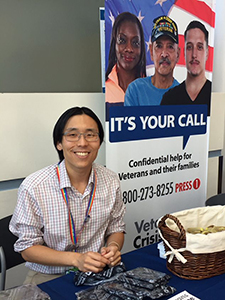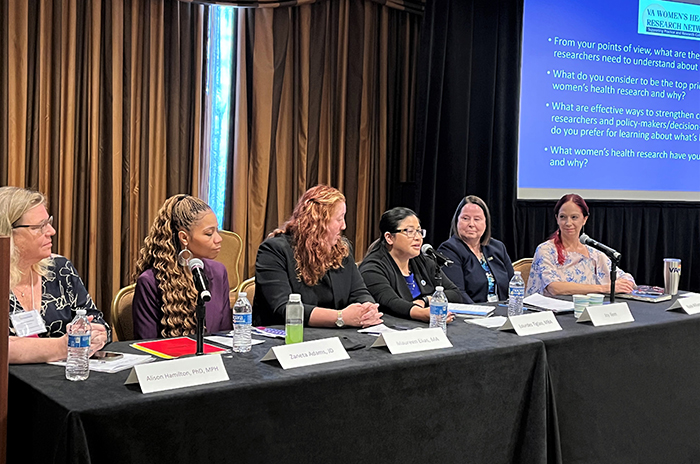Office of Research & Development |
 |


Playing music, taking part in tai chi classes, and going fishing with others are the types of activities that boost social connectedness, says Dr. Jason Chen. (Photo for illustrative purposes only. ©iStock/Vasyl Dolmatov)
April 22, 2020
By Mike Richman
VA Research Communications
"The first part of our study was to learn more from Veterans about what gets in the way of connecting."
Social isolation is often associated with suicidal behaviors, and feelings of loneliness can also increase suicidal thoughts in some people. The more people feel disconnected from their friends, peers, and colleagues, the more isolated they become.
One antidote for social isolation is social connectedness—people coming together and interacting. But there’s been little research on suicide prevention programs that target social connectedness.
With that in mind, Dr. Jason Chen of the VA Portland Health Care System is leading a study that aims to establish a stronger sense of social connectedness for Veterans at high risk of suicide by increasing their participation in community activities.

Dr. Jason Chen is leading a study that aims to promote social connectedness among Veterans at high risk of suicide by increasing their participation in community activities. (Photo courtesy of Jason Chen)
Chen and his team have been identifying the community engagement needs and preferences of Veterans who were hospitalized and evaluated for psychiatric conditions. The participants were interviewed within a week of discharging from an inpatient psychiatric unit. Veterans analyzed for psychiatric conditions, such as PTSD, are at much greater risk than other cohorts of taking their own lives within three months after leaving the hospital.
The researchers are also gathering opinions from VA staff and community representatives on Veteran community engagement following psychiatric hospitalization.
Chen and his colleagues plan to eventually create clinical toolkits for VA and community figures that focus on increasing social connectedness for Veterans in this vulnerable population.
VA considers suicide prevention its top clinical priority. The most updated analysis of Veteran suicide rates, issued in 2016, notes that Veterans accounted for 18% of all deaths from suicide among U.S. adults, compared with 22% in 2010.
Chen, who is also an assistant professor at Oregon Health & Science University, spoke to VA Research Currents.
VA Research Currents: What inspired you to pursue this study?
Chen: When working with Veterans, I noticed that many didn't have social connections. We know that feeling connected to others can be a form of protection against suicide. So I thought to myself if the Veterans I work with don't have many connections, perhaps we could help them create new connections through community activities. My hope is that by helping Veterans increase their engagement in community activities, they’ll feel a stronger sense of social connection that will, in turn, decrease their level of suicidal thoughts.
One thing I’ve found in my research is that we don't really know why Veterans aren't connecting with others. So the first part of our study was to learn more from Veterans about what gets in the way of connecting. We interviewed 30 Veterans to learn about their past experiences connecting to the community and their thoughts about what would get in the way in the future. Our Veteran sample varied in age from their 20s through their 70s. The average age was 48. We wanted to understand a broad range of experiences across different eras of conflict and generations.

VA Researcher Named One of U.S.’ Top Female Scientists

2023 VA Women's Health Research Conference

Self-harm is underrecognized in Gulf War Veterans
These Veterans were hospitalized for a broad range of psychiatric issues. What do we know about the heightened suicide risk for such patients?
One challenge in the suicide prevention literature is that we don't have a good understanding of how to decrease risk during elevated proximal risk periods. By proximal, I mean in the days and weeks before a suicide attempt. We don't know why Veterans who have been recently psychiatrically hospitalized are at much greater risk of dying by suicide within the first month after leaving the hospital than other populations.
This is not unique to Veterans. We also see this in non-Veterans who were recently hospitalized for psychiatric conditions. So this project may help us gain a better understanding of what gets in the way of bolstering social resources during high-risk periods. Patients from inpatient units show this elevated suicide risk regardless of what brings them to the inpatient unit. That’s why I was interested in looking at how Veterans engage with the community to build new connections after inpatient psychiatric hospitalization.
Regarding the types of psychiatric issues that lead Veterans to be hospitalized, it can be for a broad range of concerns, and we tried to capture that in our sample, as well. The most common psychiatric diagnoses in our sample were PTSD and depression.
What is it about social connectedness that can help Veterans at elevated risk of suicide?
Our study was informed, in part, by Dr. Thomas Joiner's Interpersonal-Psychological Theory of Suicidal Behavior, which argues that suicidal desires are driven by feeling you don’t belong and that you’re a burden on others. The goal of our project is to help Veterans create new social connections through community activities and to decrease a lack of belonging and feelings of burden. Veterans in our study generally reported they have limited engagement in community activities.
We are working on partnering with communities to provide a broad range of activities tailored to Veterans’ interests. These include engaging with Veterans or non-Veterans in the Chinese martial art tai chi or outdoor activities, such as fly fishing, or playing music. We do not have good evidence that any one type of activity is more protective than another. But they are worthwhile as long as folks are developing a sense of belonging and feel like they’re giving back to others.
Based on Joiner’s theory, emotional support is important in terms of feeling like you belong with the group. However, the program we're designing is also intended to target feeling like you're a burden on others. It seems like you need both of those pieces to find the most benefit from social connectedness. It’s important to feel like you're giving back in a reciprocal way to the folks in your social circle.
What have you found out so far about Veterans’ needs and preferences for social connectedness?
We’ve just started to look at our data. But we have identified a few patterns so far. Veterans appear to be interested in a broad range of activities. However, they noted having difficulty knowing how to access these activities and how to make new social connections. Within our sample, Veterans have discussed needing more hands-on support for engaging in community activities. They generally value and believe these activities are important for their wellness and recovery. But they could use extra support for navigating logistics and interactions with new people. We plan for this support to come from a Veteran peer support specialist. That is a Veteran who has undergone his or her own mental health recovery and is now helping support other Veterans with their experiences.
How long does an at-risk Veteran need to engage with community activities to feel a positive effect?
That's a great question. It’s hard to know how much community engagement is enough. One way I like to think about it is that we hope our program will help at-risk Veterans create long-term connections. The goal is to help Veterans develop connections from which they feel like they belong and are contributing in a meaningful way to not only prevent future suicidal crises but also provide more sources of support for day-to-day distress.
Regarding your idea to create clinical toolkits for VA and community stakeholders on suicide prevention and social connectedness, what will these toolkits contain, and who will they target?
As someone who trained as a community-based suicide prevention researcher, it’s important for me to develop products from this project that can be used by the community. I generally think of community stakeholders broadly. They can include community non-profits, Veterans’ loved ones, and others. I am currently writing a brief guide on how community organizations can partner with VA.
I realized in my early meetings with community groups that a lot of mystery existed about what our processes are. Sometimes, our VA guidelines and policies that are important for protecting Veterans can be confusing to community members. For example, one community group asked why we couldn’t inform Veteran community organizations of when Veterans are discharged from the hospital and need extra support. I had to remind them that we have legal obligations to protect the privacy and confidentiality of our Veterans. Similarly, I have heard misconceptions from VA staff on our policies.
VA, through its Office of Community Engagement and other offices, is dedicated to the importance of community partnerships. It recognizes the importance of working together with the community to develop innovative solutions for supporting at-risk Veterans. We can’t do it alone! However, sometimes that information doesn’t always reach the right audiences. We plan to submit our guide to a publicly available, online mental health policy journal.
In these difficult times when we’ve all had to engage in social distancing because of COVID-19, how much more vulnerable has that left Veterans or people in general who have had suicidal thoughts?
To be honest, we don't really know yet. I’ve heard from colleagues locally and nationally that folks are aware and attentive to this issue not only for Veterans but also for the general population.
VA Research Currents archives || Sign up for VA Research updates